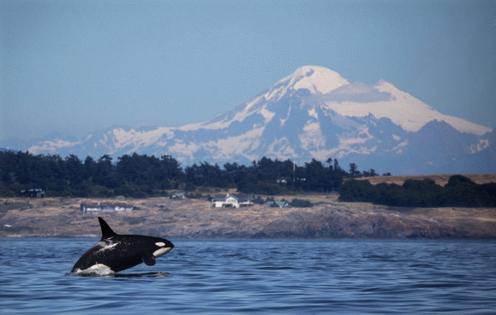Orca tally 'frustrating' for those trying to save the J, K and L pods
Published in News & Features
SEATTLE — There are only 73 southern resident orcas left in our region's waters, according to the most recent count released by the Center for Whale Research. It is one of the lowest tallies since the center counted 71 orcas when it began its survey in 1976.
The 2023 census identified 75 southern residents counted in the J, K and L pods. Since then, two adult males, K34 and L85, as well as the only baby born within the census period, the male calf J60, have died. A recently born calf, L128, was confirmed Sept. 16, which is after the census date for this year.
Orca K34 was last seen in July 2023 looking thin. He was at high risk without his mother, who had died in 2017. Mothers share their salmon catch with their male offspring, even into the calf's adulthood. Losing mom often spells trouble for sons, according to the center.
L85 was looking thin in August, and was also surviving without a mother. He was adopted by mom L12, and after she also died, he clung to L25, the oldest of all the matriarchs, before he faded away, never to be seen again, the center reported. He was one of the three oldest males in the entire population, born in 1991.
The baby, J60, had a short and tumultuous life. First spotted the day after Christmas in 2023, researchers were never sure who his mother was, as the calf was seen with first one female, then another. Could it have been a case of calf rejection? Could the mother not properly nurse? Were other females trying to help? Could it even have been a case of kidnapping? Researchers could not figure it out — and the calf disappeared and was presumed dead by early to mid-January 2024 according to the center.
The J, K and L pods have been struggling since the 1960s and '70s when anyone could catch an orca and sell it to the highest bidder in the worldwide aquarium trade. For all those years, Puget Sound was the main source, and captors sought the young, who were the cheapest to ship and easiest to train. A generation was lost, and many died terrible deaths. People killed at least 13 orcas during the captures, and 45 ended up in parks across the globe. None survive today.
The last southern resident in captivity, Lolita, died where she lived most of her life, at the Miami Seaquarium in August 2023, despite extensive efforts to release her.
The southern residents are one of three distinct populations of orca whales, actually the largest dolphin, in regional waters. Northern and southern resident killer whales specialize in eating fish, mostly Chinook salmon. Transients, or Bigg's killer whales, eat marine mammals, including seals and sea lions. Offshore whales eat mostly sharks. The southern residents are the most urban population, frequenting the waters of the Salish Sea, Puget Sound and the coast all the way south to the Golden Gate Bridge. They were listed as endangered in 2005.
The National Oceanic and Atmospheric Administration, which is charged with saving the whales, has set a goal of population growth in the pods of 2.3% over 28 years. However every time the population has started to grow in the past decade, there have been more setbacks.
"If the whales had more fish, there would be more whales, it's as simple as that," said Michael Weiss, research director for the Center for Whale Research. While the southern residents do eat other fish, salmon are the heart of their diet, and Chinook, the largest salmon, is their preferred prey. Chinook salmon are also in decline, and threatened with extinction, a sad tableau of an endangered animal dependent on a threatened one for survival.
Brad Hanson, wildlife biologist for NOAA who has studied the orcas most of his career, called the census report "frustrating."
"This is not where you want to see the population trajectory going," he said, "and not how you get to recovery."
The agency has identified several main threats to orca survival: lack of adequate, consistently available salmon, particularly Chinook; ocean noise that makes it harder for orcas to hunt; and pollution, which contaminates their food. Inbreeding has turned up the impact of all of those factors depressing their population growth, Hanson noted.
He remains convinced the orcas will eventually recover. "Given the proper conditions, these animals can prosper," Hanson said.
Progress is being made. Puget Sound is cleaner than it was a generation ago, and more cleanups are underway, including at the Duwamish River, which feeds into the Green River, where fish passage is also being funded at the Howard Hanson Dam, which blocks all of the best upriver habitat for salmon.
The Lower Elwha Klallam Tribe on Sept. 23 celebrated only its second coho fishery in more than a century on an open river on the Elwha, free of dams. Big Chinook right now are lumbering past logjams also being built in the lower river to create pools and side channels and riffles that salmon love. And the Yurok, Karuk, Shasta and Hoopa tribes of California and Klamath tribes of southern Oregon on Saturday will celebrate the removal of four dams on the Klamath River, the largest fisheries restoration dam removal ever in the world, opening 420 miles of salmon habitat.
But more work will be needed to prevent more losses within the southern resident families, which are on track toward extinction at an accelerating rate, said Rob Williams, chief scientist with Oceans Initiative. He is the lead author on a recent paper that showed the southern residents are at risk of what the authors called "bright extinction" — loss of a species not because people don't know it is happening, but because they refuse to sufficiently act. Extinction in plain sight.
Urgent action is needed, Williams said. Bold and dramatic restoration of salmon is still the strongest lever people can pull for orca recovery, and quieting the waters to make it possible for orcas to successfully hear and find their prey. "We are legally and morally obligated to put our shoulders to those levers, to get the whales more salmon, and quieter waters to hunt."
©2024 The Seattle Times. Visit seattletimes.com. Distributed by Tribune Content Agency, LLC.







Comments